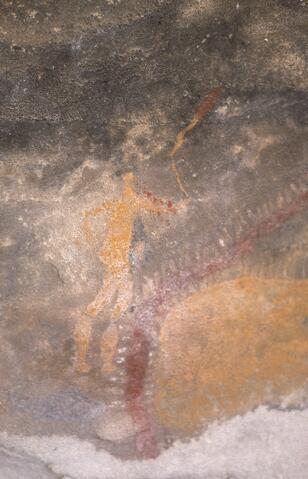Identificatie
referentie code
Titel
Datum(s)
- 31/10/2000 (Vervaardig)
Beschrijvingsniveau
Omvang en medium
Context
Naam van de archiefvormer
Biografie
Brief description of site: The shelter is screened by low vegetation and faces WSW. The shelter is formed out of very soft Clarens Formation sandstone. It has a natural rock floor, is very low (1.2 m - 1.5 m) and extends 16.8 m in length and up to 2.1 m in depth.
There is a very thin layer of damp and sandy aeolian (wind-blown) deposit in the site on top of the rock floor. There are almost no artefacts in this deposit. However, immediately in front of the shelter and off the rock floor is softer and deeper deposit that is up to 30 cm deep. Here there are numerous stone artefacts made mostly form indurated shale (hornfels) and also gem-like crypto-crystalline silicates (chalcedonies) that come from the Kraai River system. There are a few formal stone tools - notably endscrapers that were used to work leather. There are also fragments of grit-tempered pot most probably used by Sotho or Xhosa in historic times - though the San are known to have traded for pots. There are also fragments of a teapot suggesting early white or bywoner occupation of the shelter. No bone, leather, shell or wooden artefacts have been preserved. There is rudimentary stone walling - possibly to make for a sleeping hollow. There are also at least three places on the rock were grinding of plant food and/or ochre has taken place. There is a lower grindstone in the stone wall.
Brief description of art: The RSA HEL1 rock-paintings are executed in the 'Classic' or older manner as well as the more recent 'Blocked' manner and relate strongly to both San religion - which is known as shamanism - and also to the political resistance struggles of the San. 13 m of shelter wall supports approximately 77 rock-paintings.
The Rain-animal panel: This panel or image cluster measures 770 mm x 210 mm and consists of two superimposed fat red and yellow 'rain-animals'. One such rain-animal has a long red 'trunk' fringed with white 'hairs', which is surrounded by 2 yellow fish and 4 black (originally white) fish. One fish has red dots painted in its body. The darker red rain-animal was painted first and then a more recent yellow rain-animal painted on top of it. To the left and related to these two rain-animals are 12 human figures in postures indicative of a Medicine Dance. There is a large, 115 mm tall yellow human figure that bleeds from the nose surrounded by 8 smaller white human figures with red armbands. One of these smaller figures is clearly female and two of the dancers bend forward from the waist. One of the dancers has a buck head and faces the viewer.
The reason the dancers and rain-animals are related is because - in terms of San belief - the rain was an animal that lived in deep waterpools. The only way to find and catch this animal - and thus make rain - was for medicine people or shamans of the rain to enter the waterpools, calm the dangerous rain-animal down with aromatic herbs and then capture it by tying it up with thongs. Once this was done the rain-animal could then either be dragged across the sky or taken to the top of a hill and slaughtered so that its milk and blood could combine, forming life-giving rain that renewed the veld.
In our understanding, the rain-making ceremony had both observable and invisible components. The visible component was the Medicine or Trance Dance where all members of San society sang, clapped and danced in order to create a spiritually charged atmosphere. Certain San religious specialists known as shamans would also dance - often for many hours, and the physical exertion, auditory driving and belief would put them into an altered state of consciousness - sometimes called 'trance'. Sometimes naturally occurring hallucinogenic plants - such as the Boophane disticha found within metres of the rock shelter - were used. While in this altered state these shamans would experience visual and bodily hallucinations. For them these 'hallucinations' were, in fact, the Spirit World, which was believed to be full of powerful people, landscapes and beings. One such Spirit World inhabitant was the rain-animal. Care had to be taken in capturing this potentially dangerous beast that was often surrounded by the 'rain's creatures' such as tortoises and fish.
Other paintings: There are at least 6 white and red eland (Tragelaphus oryx). There are 6 white finger painted human figures that relate to the row of 6 black finger dots low to the floor. These finger paintings probably relate to Khoe (Khoi) people and are not San. There are 3 enigmatic red figures that may be human. There are at least two small panels depicting white bags - one 100 mm x 163 mm with white dots. There is a white cat-like creature. One white human figure bears long sticks and a characteristic lozenge-shaped Xhosa shield. This figure has a massive head. One red buck glances over its shoulder. On ceiling 11 black (once white) buck appear to leap into a hollow in the ceiling.
Naam van de archiefvormer
Biografie
Nationality: South African
Created by: willem
Created on: 11/03/2003
Naam van de archiefvormer
Biografie
archiefbewaarplaats
Geschiedenis van het archief
Directe bron van verwerving of overbrenging
Inhoud en structuur
Bereik en inhoud
Waardering, vernietiging en slectie
Aanvullingen
Ordeningstelsel
Voorwaarden voor toegang en gebruik
Voorwaarden voor raadpleging
Voorwaarden voor reproductie
Taal van het materiaal
- Engels
Schrift van het materiaal
Taal en schrift aantekeningen
Fysieke eigenschappen en technische eisen
Original size: 35mm

